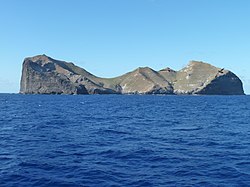Nihoa
 |
|
| Geography | |
|---|---|
| Location | Papahānaumokuākea Marine National Monument |
| Coordinates | 23°03′38″N 161°55′19″W / 23.06056°N 161.92194°W |
| Archipelago | Northwestern Hawaiian Islands |
| Area | 0.69 km2 (0.27 sq mi) |
| Administration | |
|
United States
|
|
| Demographics | |
| Demonym | Nihoan |
| Population | 0 |
|
Nihoa Island Archeological District
|
|

View of Nihoa Island
|
|
| Nearest city | Kauai, Hawaii |
|---|---|
| NRHP Reference # | 88000640 |
| Added to NRHP | June 13, 1988 |
Nihoa (/niːˈhoʊ.ə/; Hawaiian: [niˈhowə]), also known as Bird Island or Moku Manu, is the tallest of ten islands and atolls in the uninhabited Northwestern Hawaiian Islands (NWHI). The island is located at the southern end of the NWHI chain, 296 km (160 nmi) southeast of Necker Island. Nihoa is the closest NWHI in proximity to the eight main windward Hawaiian Islands at approximately 240 km (130 nmi) northwest of the island of Kauaʻi. The island has two peaks, 272 m (892 ft) Miller's Peak in the west, and 259 m (850 ft) Tanager Peak in the east. Nihoa's area is about 171 acres (0.69 km2) and is surrounded by a 142,000-acre (57,000 ha) coral reef. Its jagged outline gives the island its name, Nihoa, which means "tooth" in the Hawaiian language.
The island is home to 25 species of plants and several animals, making it the most diverse island in the entire NWHI. Endemic birds like the Nihoa finch and Nihoa millerbird, and endemic plants like the Nihoa fan palm, the Nihoa carnation, and Amaranthus brownii are found only on Nihoa. The plant communities and rocky outcrops provide nesting and perching areas for 18 species of seabirds, such as red-footed boobies and brown noddies, terns, shearwaters, and petrels. Prehistoric evidence indicates Native Hawaiians lived on or visited the island around AD 1000, but over time the location of Nihoa was mostly forgotten, with only an oral legend preserving its name. Captain James Colnett rediscovered the island in 1788, and Queen Kaʻahumanu visited it in 1822. It was made part of the Kingdom of Hawaii by King Kamehameha IV.
...
Wikipedia


